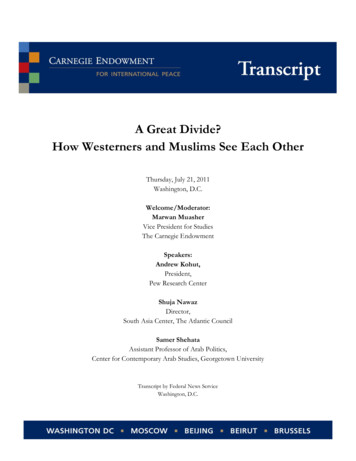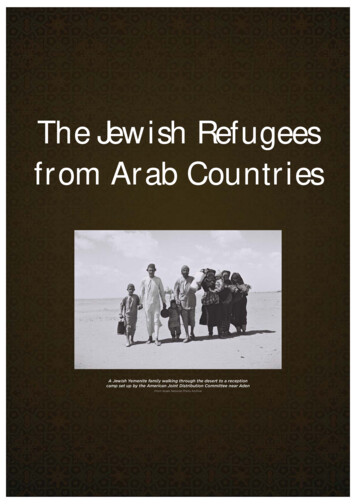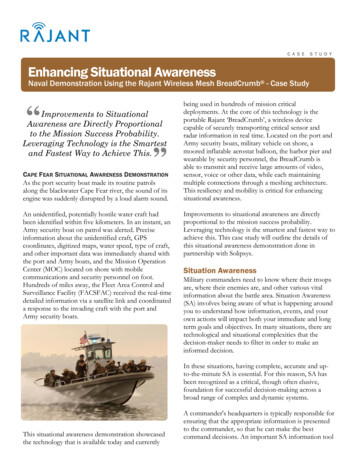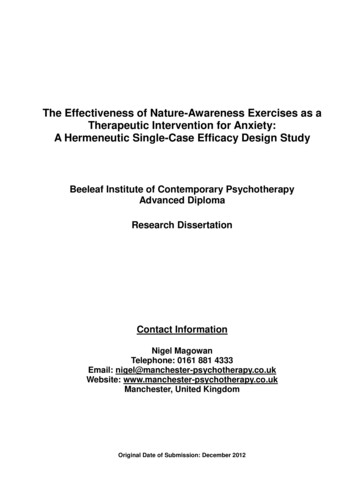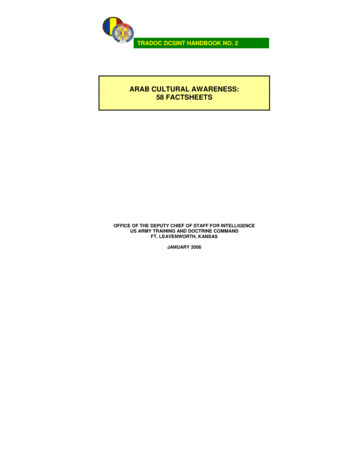
Transcription
TRADOC DCSINT HANDBOOK NO. 2ARAB CULTURAL AWARENESS:58 FACTSHEETSOFFICE OF THE DEPUTY CHIEF OF STAFF FOR INTELLIGENCEUS ARMY TRAINING AND DOCTRINE COMMANDFT. LEAVENWORTH, KANSASJANUARY 2006
PURPOSEThis handbook is designed to specifically provide the trainer a ‘hippocket training’ resource. It is intended for informal squad or smallgroup instruction. The goal is to provide soldiers with a basicoverview of Arab culture.It must be emphasized that there is no “one” Arab culture or society.The Arab world is full of rich and diverse communities, groups andcultures. Differences exist not only among countries, but withincountries as well.Caveat: It is impossible to talk about groups of people withoutgeneralizing. It then follows that it is hard to talk about the culture of agroup without generalizing. This handbook attempts to be as accurateand specific as possible, but inevitably contains such generalizations.Treat these generalizations with caution and wariness. They doprovide insight into a culture, but the accuracy and usefulness willdepend on the context and specific circumstances.Comments or Suggestions: Please forward all comments,suggestions or questions to: ADCINT-Threats, 700 Scott Ave, Ft.Leavenworth, KS 66027 or emailpenny.mellies@leavenworth.army.mil or phone 913.684.7920/DSN552-7920.ii
WHERE IS THE ARAB WORLD? The Arab world stretches from Morocco acrossNorthern Africa to the Persian Gulf. The Arab worldis more or less equal to the area known as theMiddle East and North Africa (MENA). Although thisexcludes Somalia, Djibouti, and the Comoros Islandswhich are part of the Arab world.It can also be defined as those countries whereArabic is the dominant language.KEY: Arab countries are religiously and ethnicallydiverse with Islam being the dominant religion inmost countries.22 Arab countries/areas: Algeria, Bahrain, theComoros Islands, Djibouti, Egypt, Iraq, Jordan,Kuwait, Lebanon, Libya, Morocco, Mauritania, Oman,Palestine, Qatar, Saudi Arabia, Somalia, Sudan,Syria, Tunisia, United Arab Emirates, and Yemen.Iran and Turkey are not Arab countries.1
STRATEGIC IMPORTANCE OF ARAB WORLD 222 countries.Location of several world religions.Multitude of ethnic and linguistic groups.Close to 60% of earth’s oil reserves are at or nearthe Arabian Peninsula.Saudi Arabia possesses the world’s largestreserves of oil.
WHAT IS AN ARAB? Over 200 million Arabs worldwide. To be an Arab, is not to come from a particular race orlineage. To be an Arab, like an American, is a cultural traitrather than racial. The Arab world includes Muslims, Christians and Jews. Any person who adopts the Arabic language is typicallycalled an Arab. Arabic is the official and the original language of theQur’an, the Islamic holy book.3
COMMOM MISCONCEPTIONS ABOUT ARABS All Arabs are Muslims, and all Muslims are Arab.oArabs are religiously diverse group –significant numbers of Arab Christians inEgypt, Lebanon, Syria, Palestine, Jordan, andIraq. Arabs make up between 15-18% of theMuslim world. The Arab world is backwards and uncivilized.oActually represents a highly developed cultureand civilization where modern cities minglewith ancient ones. The Arab world is one big desert.oTruly geographically complex and diverse. Stereotypes of Arab males:oAll are “oil-rich Sheiks”. As in the West, thereare economically diverse segments of thepopulation.oMad dictators. Various types of politicalsystems in Arab world.oTerrorists. Overwhelming majority are lawabiding citizens with families and a widevariety of occupations. Stereotypes of Arab women:oAll are oppressed by men. Not true.o All are veiled. According to Islam women aresupposed to wear veils. In some countries, likeLebanon, Syria and Egypt, it is no imposedupon them and women are free to choosewhether to wear veils. However, in otherplaces, all women, even non-Muslims, wearveils out of fear of mistreatment by fanatics orthose who pretend to be guardians of Islam.4
ARAB POLITICS Politically diverse forms of government in Arab world.o Parliamentary Republics in Algeria, Egypt,Lebanon, Tunisia, Syria, Iraq, Libya andYemen.oTraditional monarchies in Oman, Qatar,Bahrain, Kuwait, United Arab Emirates andSaudi Arabia.oJordan and Morocco are constitutionalmonarchies.Religion does play a role in Arab politics in manydifferent ways.oLebanon – Parliamentary representation isdivided according to religious affiliation(Muslim, Christian, and Druze).oJordan/Morocco – King bases legitimacy ondirect descent from the Prophet Mohammed,but he is not a religious leader.5
ARAB DISUNITYNot all Arabs agree on everything. Major differences existbetween Arab counties. These differences have lead to conflictand disunity across the Arab world. For example:6 Country Boundaries not aligned with tribal / ethnicconcerns. Relations with Israel. Differences among Arab states inwhat the relationship to Israel should be but it should benoted that the majority of the people of these states have“hard feelings” against Israel. Rivalry within the Arab World. Countries not alwaysin agreement and are sometimes at odds with eachother. Iraq’s Saddam Hussein and the late Hafaz Assadof Syria each claimed leadership in the Ba’athmovement and were bitter enemies as each wasunwilling to defer leadership to the other. Sunni – Shi’a Schism. Violence has widened the dividebetween the two major sects of Islam, and persecutionof the Shi’a minority has the potential to spark intoarmed conflict and civil war in certain parts of the MiddleEast. Politics of Oil. Oil has made some Gulf States very richwhile Jordan, Syria, and Egypt are relatively poor andthis causes animosity and hard feelings.
ARAB DRESS, MENArab dress for men ranges from the traditional flowing robes to bluejeans, T-shirts and western business suits. The robes allow formaximum circulation of air around the body to help keep it cool, andthe head dress provides protection from the sun. At times, Arabs mixthe traditional garb with Western clothes.Headdress pattern might be an indicator of which tribe, clan, or familythe wearer comes from. However this is not always the case. While inone village, a tribe or clan might have a unique headdress, in the nexttown over an unrelated tribe or clan might wear the same headdress.HeaddressCheckered headdresses relate to type and government andparticipation in the Hajj. Red and white checkeredheaddress – Generally ofJordanian origin. Wearer hasmade Hajj and comes from acountry with a Monarch. Black and white checkered headdress – The pattern ishistorically of Palestinian origin. Black and grey representPresidential rule and completion of the Hajj. Shi’a- black turbans associated withShi’a clergy who are somehowconnected to the ProphetMuhammed or Ali Ibn Abi Talib thecousin of the Prophet who was the4th Khalif of Islam and leader of theShi’a sect. Those who wear white turbans are associatedwith the lower echelons of the Shi’a hierarchy.7
ARAB DRESS, WOMEN8 Adherence to traditional dress varies across societies. (Moretraditional—Saudi Arabia Less traditional – Egypt) Traditional Arab dress features the full length body cover(abayah, jilbob, or chador) and veil (hijab or chador). Concerns of modesty are the reason for the dress. The most devoted women cover their faces as well as thebodies in veils/robes. Rural women, who typically work in the fields, may wear lessrestrictive garments lighter in color and weight.
WOMEN IN ARAB SOCIETIESArab women are typically subordinate to men in their societies. Theextent varies by country. The most restrictive conditions exist on theArabian Peninsula, and the most relaxed conditions exist in the urbanareas of Egypt, Syria and LebanonTHINGS TO DO:¾¾¾Respect the privacyand protected role ofwomen in Arabsocieties.Men stand whenwomen enter aroom.Respect the different living “areas” for men and women.Do not expect women to eat or socialize in the sameroom as men.THINGS NOT TO DO:¾¾¾¾¾Do not shake hands with an Arab woman unless sheoffers her hand first, or if you are a woman. Do not flirt,hit-on, touch, hug or talk in private with women. ITCOULD ENDANGER THEIR SAFETY!Do not talk in public to professional Arab women unlessit is business related.Do not try and engage a woman in conversation unlessyou have been formally introduced.Do not stare at women or maintain eye contact.Do not ask an Arab questions about his wife or otherfemale members of his family.9
FAMILY10 The family is the key social unit to an Arab. This loyaltyinfluences all aspects of an Arab’s life. Arabs honor and respect their family. They highly valuefriendships. Family and kin’s honor most important. Patriarchal and hierarchal: Fathers/elders dominate Larger the better: Large families provide for possibleeconomic benefits, particularly for the possibility that ason will care for hisparents in their elderlyyears. Large familiesprovide the father withthe prestige of virility. Clan and then tribe interms of loyalty followfamily as a social unit,although most contemporary Arabs express a nationalidentity as well. Children: Male offspring are favored, since a son isexpected to care for his parents in their advanced age,whereas a daughter becomes part of the son-in-law’sfamily. Also, a son can bring a family honor, whereas adaughter can only bring shame. Women typically have a private area in the householdseparate from men, especially in rural areas.
YOUTH EXPLOSION IN THE ARAB WORLDStatistics show a dramatic increase in the number of persons lessthan 15 years of age in the Arab world. Rates in the developed world are around 20%.Rates in the developing world are around 35%.Rates in the Arab world are 42%.The impact of this increase could be positive and/or negative and willdepend upon how each country addresses the issue. Positive: Increase labor pool, new talent and leadershippotential.Negative: If economy cannotsupport (jobs, education, etc.)growing youth bulge –discontent and social unrestare likely.11
ARAB Perspective vs. WESTERN PerspectiveARAB Family – Center of everything. (Father has first and lastword.)Friends – Periphery, but courteous to all.Honor – Very Important amongst Arabs. Honor will beprotected and defended at all costs.Shame (especially against family) – avoided at all costs,insults and criticism taken very seriously.Time – less rigid. Approach to time is much more relaxedand slower than that in Western cultures.Religion – Central to all things.Society – Family / tribe is most importantGovernment – Most governments are secular, but stillemphasize religion.Age and Wisdom honored.Wealth honored in both cultures.WESTERN 12Family – Important but not as central to individual.Friends – Core to some, important to most.Honor – Typically not as important.Shame – Typically not as important.Time- Very structured, deadlines must be met.Religion – Varies by individual, very personal, notdiscussed in polite conversation.Society – Individual rights.Government – Purpose is to protect rights and improvestandard of living.Youth and Beauty praised.Wealth honored in both cultures.
ARAB WORLDVIEWAn Arab worldview is based upon six concepts: atomism, faith,wishes versus reality, justice and equality, paranoia andthe importance of family over self.ATOMISM. Arabs tend to see the world and events as isolatedincidents, snapshots, and particular moments in time.Westerners tend to look for unifying concepts whereasArabs focus on parts, rather than on the whole.FAITH. Arabs usually believe that many, if not all, things in lifeare controlled by the will of God (fate) rather than byhuman beings.WISH VERSUS REALITY. Arabs, much more thanWesterners, express emotion in a forceful and animatedfashion. Their desire for modernity is contradicted by adesire for tradition (especially Islamic tradition).IMPORTANCE OF JUSTICE AND EQUALITY. Arabs valuejustice and equality among Muslims, and to a lesserdegree to others. All actions taken by non-Arabs will beweighed in comparison to tradition and religious standards.FAMILY VERSUS SELF. Arabic communities are tight-knitgroups made up of even tighter family groups. Familypride and honor is more important than individual honor.PARANIOA. Arabs may seem paranoid by Western standards.Many are suspicious of any Western interest or intent intheir land.13
ARAB CUSTOMSSHAME and HONOR Admitting, “I don’t know” is distasteful to an Arab.Constructive criticism can be taken as an insult. Becareful not to insult.Women wear headscarves as a show of respect, even ifwearing Western clothing.FAMILY Family is the center of honor, loyalty, and reputation forArabs.Males are always the head of the Arab family.PERSONAL SPACE Most Arabs DO NOT share the American concept of“personal space” in public situations, and in privatemeetings or conversations. It is considered OFFENSIVETO STEP OR LEAN AWAY! Women are an exceptionto this rule. DO NOT stand close to, stare at, or touch awoman.SOCIALIZATION and TRUST14 When conducting business, it is customary to first shakethe hand of all males present, taking care not to grip toofirmly. Allocate plenty of time for refreshment before attemptingto engage in business. It is important to first establishrespect and trust.
ARABIC CALENDAR/HOLIDAYS2006Festival200729 Dec – 01 JanHajj18-21 Dec10 JanEid al-Adha20 Dec10 FebIslamic New Year20 Jan19 FebAshura29 Jan21 AprilMohammad’s Birthday31 March05 – 24 OctRamadan13 Sept-12 Oct29 OctLayla tul-Quar8 Oct04 NovEid al-Fitr13 Oct Islamic practices are based on the lunar calendar orcycle, consisting of twelve months of 29 or 30 dayseach, totaling 353 or 354 days. Each new month begins at the sighting of a new moon.Actual dates may differ from dates provided. The holy day of the Muslims is FRIDAY. It isconsidered to be sacred and the Day of Judgment willtake place on Friday. In the Friday sermon the Imam(prayer leader) gives the sermon (Khutba) and leadsprayer.15
EATING ETIQUETTE 16Arabs are restricted by Islamic conventions from eating pork,most carnivorous animals, and unscaled fish. Alcohol isforbidden.Meat must be butchered in line with Qur’anic ritual (know asHallal “permitted”)The staple of the Arab diet is dark pita bread.Lamb is the most common meat.Always offer snack foods to visitors and accept what isoffered to you as a guest, butonly after modestly refusingthe first offer.It is assumed that guests willaccept at least a smallquantity of drink (tea usuallyor sometimes Arabic coffee)offered as an expression offriendship or esteem. It isconsidered rude to decline the offer of drink.When served a beverage, accept with the RIGHT HANDONLY! When eating, drinking, offering, or passing useright hand only!When eating with Arabs, especially when taking food fromcommunal dishes, the left hand must never be used, it isconsidered unclean.Not eating everything on one’s plate is considered acompliment. It is a sign of wealth when an Arab can afford toleave food behind. If invited to an Arab home, leave shortlyafter dinner. The dinner is the climax of conversation andentertainment. Avoid discussions on political issues (nationaland international), religion, alcohol, and male-femalerelations over dinner or tea.
HYGIENE Personal hygiene is extremely important to Arabs for bothspiritual and practical reasons. Because meals are frequently eaten by hand, it is typical towash the hands before and after eating. Formal washing of face, hands, and forearm required beforedaily prayers or fasting. Some interpretations of the Qur’an suggest that all flowingwater is clean, to include that coming from open air canalswithin the cities that are sometimes garbage or sewageclogged. The immunity systems of Arabs accustomed to thiswater prevents ill effects, but Westerners should only usewater from a trusted source.17
ARAB HOMES Homes vary from one room to multiple room dwellings. One room homes may be curtained into sections to makesleeping areas. The walls are made from mud mixed with thechaff from wheat and most oftenare left the tan mud color althoughthey can be painted a white or lightcolor. The walls tend to be thickernear the ground and tend to taperoff as the walls approach the roof.Roofs tend to be flat topped, sincethe lack of rain does not warrant asloped roof. The poor tend to build their dwellings slightly belowground and everyone sleeps on the floor to escape the summerheat. Only female soldiers should search the women’s quarters in aMiddle Eastern home.18
BODY LANGUAGE AND GREETINGSBody Language takes on extra significance in Arab culture. The bodylanguage is distinctly different and must be learned in order toeffectively reinforce the intended message, and perhaps moreimportantly to not give unintended insults. Shake Hands with right handonly and at the beginning andend of any visit. Shake handslonger but less firmly than inthe West. Left hand graspselbow. Close friends or colleagues hug and kiss both cheeks upongreeting. During the Hajj (pilgrimage), people may kiss onlyon the shoulders as a gesture of friendship and greeting.Touching noses together three times when greeting is aBedouin gesture of friendship andrespect. Placing a hand on your heartalong with a slight bow is a signof respect. This is usually doneduring greeting.US soldiers should limit physical contact to a handshake.19
BODY LANGUAGE w/SPECIFIC MEANING“It’s my Obligation” - The gesture of placing the right hand or itsforefinger on the tip of the nose, on the right lower eyelid, on top of thehead, on the mustache or beard has the meaning of "it’s in front ofme, I see it or it’s on my head to accomplish."”Come Here” -Right hand out, palm down, with fingers broughttoward oneself repeatedly in a clawing motion, is the sign for callingsomeone to come.”I’m thinking” - Grasping the chin with the thumb side of the right fistis a sign of wisdom or maturity.“Slow down” - By holding the fingers in a pear shaped configurationwith the tips pointing up at about waist level and moving the handslightly up and down signals "wait a little bit" or "be careful. " Thisgesture can be observed extensively when driving in the crowdedstreets of the Arab cities. In such a locale, it may be accompanied bycurses from an anxious taxi driver or a pedestrian trying to cross thestreet.”Thank You” - Placing the palm of the right hand on the chest,bowing the head a little and closing one’s eyes connotates "ThankYou" (in the name of Allah).“No” – A quick snap of the head upwards with an accompanying clickof the tongue connotates: "No", "Unlikely", or "What you say is false.“20
BODY LANGUAGE – PART 2The conventions in the Middle East are that socialinteraction and conversation among Arabs occurs at amuch closer distance than normal in the Western Worldand well within the “personal space” defined by the West.¾¾¾¾¾¾Long handshakes, grasped elbows, even walking handin hand by two males is common place in the Arabworld.A considerable number of Arabs touch more betweenthe same sex. They hold hands, hug each other.As Arab society condones the outward display ofaffection between male friends, one may see Arabmen, even officials and military officers, holding handsas they walk together or otherwise converse with oneanother.If an individual Arab does not touch you, he does notlike you--or he may be trying to restrain himselfbecause you are not used to being touched.A full body embrace, accompanied with hugging,should not be initiated until you are sure that the Arabis a close friend. If the Arab initiates it, participate andconsider yourself honored and/or accepted.Contact between the opposite sex in public isconsidered close to obscene. Eye contact duringdiscussions--often long and direct--is important. Staringis not necessarily rude (except gazing at women).21
BODY LANGUAGE – PART 3“I wish evil upon you” - Biting the right forefinger,which has been placed sideways in the mouth, maybe a threat or an expression of regret. In Westernculture the "A-OK" sign is a positive gesture.However in the Arab world, if the gesture is shakenat another person it symbolizes the sign of the evileye. An Arab may use the sign in conjunction withverbal curses.”I wish you harm” -Hitting the right fist into the openpalm of the left hand indicates obscenity orcontempt.”You’re lying” - Placing a half closed hand in front ofthe stomach, and then turning it slightly connotesthat the person to whom the gesture is made is a liar.”I insult you” - Placing the tips of the left fingers andthumb together so that the hand faces right, thenplacing the tip of the right forefinger directly on theleft fingertips indicates an obscenity or insult directedat one’s birth or parentage.”You are unimportant” - Showing soles while sitting isconsidered rude. and symbolic of “you beingbeneath my feet”. Sit instead with soles toward or onground to be polite. Also maintain eye contact; lackof eye contact strongly conveys “you areunimportant” as well.Warning! Gestures indicating obscenities or insultsshould not be used by non-Arabs. Arab gestures of thistype have varying degrees of intensity. Depending uponthe circumstances and country, incorrect usage could leadto serious offenses and cause diplomatic incidents.22
COMMUNICATIONSVerbal The love of talk stems from the rich nomadic oral tradition ofgreeting travelers and exchanging information.Low literacy rates increase the importance of verbalcommunication.Arabs love poetry and creative speech. They are fond ofbestowing flowery blessings and colorful swearing.When speaking with Arabs keep in mind that they believe thatwords have power. Arabs shun speaking about unpleasantriesout of fear that negative speech compels negative results.Also, they will use euphemisms when discussing the plight ofothers. For instance, say a mutual acquaintance is ill and neardeath. Should you inquire about recent news he will likelyrespond, “he is well, but a little tired.” In an operationalsituation check the facts after being briefed by an Arab soldierbecause he may be sugar coating a bitter pill.Written Muslims, particularly Arab Muslims, consider the ArabicLanguage holy as the Qur’an is written in Arabic. The writtenword has special meaning to them and is respected by theliterate and the illiterate alike.Arabs consider advanced education a remarkable achievementand greatly respect scholars and learned men and women.Avoid using newspapers in “unclean” ways as many Arabicnewspapers usually have some reference to Allah and someArabs could be insulted in how the printed name of Allah istreated.23
SUGGESTIONS FOR SUCCESSFUL MEETINGS24 Location: Choose a pleasant quiet, private locationaway from distractions. Plan a light agenda: Middle Easterners resistpressure to accomplish too much at an initial meeting.Initial meetings are usually only considered as ‘meetand greet’ opportunities to judge if negotiation might bepossible in the future. Expect tardiness: The Middle East has a laxmentality on the necessity for punctuality and few wearwatches. Tardiness is not a sign of disrespect anddoes not warrant an apology unless the tardiness isexcessive (more than 90 minutes). Greetings: Spend double the time with greetings andsalutations. Greet Arabs in rough order of seniority. Donot attempt to shake hands with an Arab female unlessshe initiates the handshake first. Greeting Gifts: Gifts are appropriate particularly if thediscussions occur in a home. Gifts must be wrapped.Politely refuse gifts at least twice. Do not open a gift infront of the gift-giver. Manners: Courtesy is essential. Meetings begin withniceties and small talk.
SUCCESSFUL MEETINGS – PART 2 Translators: Be aware of complexities involved withworking with translators. Your translator might have anagenda, or his dialect or tribal affiliation might not bewell received. (For meetings, check in advance iffemale translator is okay). Eye to Eye Contact: Maintain eye to eye contact withyour counterpart even if talking through a translator.Do not wear sun glasses even if the meeting isoccurring in bright sun light. Refreshments: Beverage refreshments of tea andcoffee should be available. Offer or expect to beoffered tea at least three times, say yes at least twice.Never offer alcohol. If the meeting is expected to belengthy have snacks available or a meal prepared. Hierarchy is followed in social interaction. Look for theelder in the group when you need to gain allies. Time: Do not look at a watch or clock during themeeting. Doing so suggests to your host or guest thatyou consider them unworthy of your time. Closing Gifts: Gifts may be presented publicly to thegroup at the meeting’s end. Photography: Always ask permission.25
SUCCESSFUL NEGOIATION SUGGESTIONS26 Use Policies of Inclusion: Consult and involve innegotiations all the power brokers that have the ability toaffect your project. Xenophobia: Be prepared for some distrust of foreigners.Historically, Middle Easterners perceive foreigners in theMiddle East as invaders or exploiters. Bartering: Expect Bartering- Expect an Arab to ask for whathe wants rather than merely what he needs. Work towards asatisfactory medium. Personal Provisions: Some Arabs may ask for provisionsthat appear self-serving. Personal rewards are a normal partof negotiation in the Arab world. Commitment: Do not put your guests / hosts in a position tocommit to a firm ‘yes’ or ‘no’ in front of other Arabs. Socialpressure could compel your guest/host to agree to acommitment he has no intention of keeping. Long Range Planning: Never accept a firm commitmentfarther than a week out at face value. Arab culture and theconcept of fatalism are not conducive to long range planningand require at least a confirmation in the week prior to theplanned event. Compliance: To compel an Arab to keep a commitment inwhich he appears not to be keeping, attempt an indirectapproach first before direct confrontation. Having a peergently remind him of his commitment, could prevent him fromfeeling an affront to his honor. Keep verbal commitments orrisk reinforcing the perception that “America never keeps itspromises”.
ISLAM Islam. ‘Islam’ in Arabic means ‘submission’,or specifically, submission to the Allah’s willand obedience to His law. One God. Islam is a strictly monotheisticreligion. God is ‘Allah’. Allah is immortal, omniscient,omnipresent, and genderless. Islam is the final word of God. AlthoughJudaism and Christianity preceded Islam andworships the same God as Islam, Islamclaims to be more refined than them in that itbuilt upon both. Muhammad is God’s Prophet. Muhammadis not to be worshiped but is to be respectedand revered. Muhammad’s life and teachingsprovide the examples of how one is to live hislife.27
MUSLIMS28 Followers of Islam are called Muslims. There are 1.3 billion Muslims worldwide. Muslims are not to be confused withArabs. Muslims may be Arabs, Turks,Persians, Indians, Pakistanis, Malaysians,Indonesians, Europeans, Africans,Americans, Chinese, or other nationalities. 12% of the world’s Muslims are Arabs. The US, with 5-6 million Muslims, has the20th largest Muslim population. Turkey and Iran, not Arab countries, arethe most populous Muslim nations in theMiddle East. The most populous Muslim nation in theworld is Indonesia. Egypt, not Saudi Arabia, is the mostpopulous Arab Muslim nation.
ARAB CONCEPT OF REVENGE The Arab concept of revenge is a strongcultural force.The Old Testament’s and Qur’an’s passagesthat advocate “an eye for an eye” dominateArab culture.The conflict continues even after thebelligerents have killed each other off, becausepreviously uninvolved family and/or tribalmembers expand the fight seeking revenge.The ancient tribal custom of ‘fasil’compensation, mentioned within the Qur’an as‘diya’, and advocated by Islam, presents a wayto defuse the revenge perpetuated cycle ofcontinued conflict.‘Diya’ is an obligatory, non-negotiable paymentof blood money used in cases of accidentalkillings.‘Fasil’ is an Iraqi term for a negotiatedsettlement that is paid even after intentionalkillings.‘Fasil’ does not have to be financial. Theperpetrator can agree to be exiled from aneighborhood, village or region.29
COMMON ISLAMIC TERMS30 FATWAH: A legal pronouncement in Islam usually issued at therequest of a judge or individual to settle a question when Islamic lawis unclear on the subject. IMAM: Community religious leader/clergy (bishop). In somecontexts, ‘Imam’ merely refers to the prayer leader. KHALIFA: Political Sunni leader chosen by elders. QUR’AN: Islamic Holy Book, given by Allah to the ProphetMohammad. MADRASSAH: A school. Normally secular with some integratedIslamic subjects, sometimes purely Islam oriented. MOSQUE: Muslim place of worship similar to a church or temple. MUEZZIN: Person who calls faithful to prayer. MUFTI: A Sunni Islamic law scholar who is an interpreter of IslamicLaw (Sharia) and capable of issuing a fatwah/fataawa. AYATOLLAH: A Shia Islamic law scholar who is an interpreter ofIslamic Law (Sharia) and capable of issuing a fatwah/fataawa. MULLAH: Local religious leader/clergy (minister). QADI: Judge of the Sharia Islamic law. SHARIA: Islamic Law. SHEIK: Leader of a family/village/tribe or mosque. SUNNI and SHI’A: Two main branches of Islam. WAHABBIs: Puritanical Muslims from the Hanbali school of SunniIslam. Never shave their beards.
ISLAM’S FIVE PILLERS OF FAITHSHAHADAH - Declaration of FaithThis declaration of faith is called the Shahadah. Thesignificance of this declaration is the belief that the onlypurpose of life is to serve and obey God, and this isachieved through the teachings and practices of the LastProphet, Muhammad.SALEH – PrayerSaleh is the name for the obligatory prayers that are performedfive times a day, and are a direct link between theworshipper and God.ZAKAH – AlmsAn important principle of Islam is that everything belongs toGod, and that wealth is therefore held by human beings intrust. The w
To be an Arab, like an American, is a cultural trait rather than racial. The Arab world includes Muslims, Christians and Jews. Any person who adopts the Arabic language is typically called an Arab. Arabic is the official and th
